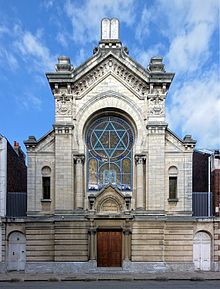Reference




OpenAI's Answer
The architecture and style of synagogues have varied greatly across different regions and periods, reflecting local cultural influences, available materials, and community needs. Here are some key points highlighting these differences:
General Characteristics
- Lack of Standardization:
- Unlike churches, synagogues do not follow a single architectural blueprint. They are typically oblong or square rather than cruciform.
- Functional Elements:
- Despite variations, most synagogues feature essential elements such as the Ark (aron kodesh) where Torah scrolls are kept, a bimah (platform), and an eternal light (ner tamid).
Regional Differences
-
Europe:
- Gothic Influence: In Western Europe, particularly during the 19th century, many synagogues adopted Gothic Revival styles, characterized by pointed arches and intricate stonework.
- Baroque and Rococo: Eastern Europe saw a mix of Baroque and Rococo elements with ornately decorated interiors.

- Gothic Influence: In Western Europe, particularly during the 19th century, many synagogues adopted Gothic Revival styles, characterized by pointed arches and intricate stonework.
-
Middle East and North Africa:
- Moorish Style: Reflecting Islamic architectural influences, many synagogues in these regions feature horseshoe arches and intricate tilework.

- Ottoman Influences: Domes and arches are also prevalent, similar to local mosques.
- Moorish Style: Reflecting Islamic architectural influences, many synagogues in these regions feature horseshoe arches and intricate tilework.
-
China:
- Kaifeng Synagogue: Synagogues in Kaifeng blended traditional Chinese architectural elements with Jewish necessities, featuring wooden structures and tiled roofs.
- Kaifeng Synagogue: Synagogues in Kaifeng blended traditional Chinese architectural elements with Jewish necessities, featuring wooden structures and tiled roofs.
-
United States:
- Eclectic Styles: American synagogues exhibit a mix of various historical styles, often incorporating elements from Gothic, Romanesque, and Beaux-Arts architectural schools.

- Modernist Approaches: Post-World War II synagogues often utilize modernist architecture with simple geometric forms and new materials like glass and steel.
- Eclectic Styles: American synagogues exhibit a mix of various historical styles, often incorporating elements from Gothic, Romanesque, and Beaux-Arts architectural schools.
Materials and Construction
- Europe: Stone and brick were common, providing both durability and a means to integrate with local architectural styles.
- North America: Earlier synagogues used wood, while later buildings incorporated steel and concrete, reflecting advances in construction technology.
- Middle East and North Africa: Local materials such as mudbrick and stone were predominant, integrating the synagogues into their environments.
Conclusion
Synagogue architecture is a rich tapestry that reflects the diverse cultural interactions and historical contexts of Jewish communities worldwide. While the core functional elements remain consistent, stylistic and construction choices vary greatly, influenced by the surrounding architectural trends and materials available locally. For a more comprehensive overview, you can explore resources like the Wikipedia on Synagogue Architecture and MyJewishLearning on Synagogue Design.
Follow Up
Related
What is the total cost of constructing the ReSoWi building?
Question 1 [50 marks] Case Study 1: CSR Project Gone Wrong Jadec Consulting is a software firm ope
Question 1 [50 marks] Case Study 1: CSR Project Gone Wrong Jadec Consulting is a software firm ope
What are the specifications of the hydrographic survey ships listed?
What types of wood are categorized as softwoods and hardwoods?
